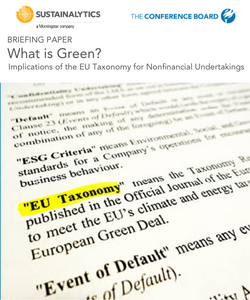What is Green? EU Taxonomy for Sustainable Activities
January 27, 2022 | Report
Executive Summary
The EU aims to be climate neutral by 2050 and wants to accelerate and incentivize investment into sustainable activities to support its carbon neutrality goal. This goal raised an important question within the EU: How does one define a “sustainable activity”? In the absence of any definition or systematic guidance on what is sustainable, the EU has introduced a framework that classifies “green” economic activities.
Insights for What’s Ahead
- Companies in Europe need to prepare for the first version of Taxonomy reporting in their 2022 annual or sustainability reports. Undertakings that are required to report on nonfinancial information under the Non-Financial Reporting Directive (NFRD) and financial market participants that offer financial products in the EU will be required to publish their first Taxonomy Eligibility Report in 2022, covering the financial year 2021. Expanded disclosure will be required from 2023.
- As parts of the Taxonomy and the associated reporting requirements are still not finalized, companies in Europe need to follow these developments closely. The Taxonomy encompasses six environmental objectives, and for now the European Commission has adopted a “delegated act” (a nonlegislative act that amends or supplements nonessential parts of the legislation after experts have weighed in) for only the first two objectives: climate change mitigation and climate change adaptation. A second delegated act for the remaining objectives is expected to be published in 2022 and companies will be expected to report on those from 2023. Further, the EU has also published a consultation to extend the green taxonomy to cover contributions to social and human rights objectives. While the proposed timeline for the social taxonomy is unclear, companies might be required to report on social issues from 2024 or 2025.
- Companies that aren’t subject to the EU Taxonomy should consider assessing their preparedness to report on a voluntary basis. European companies that are exempt from the Taxonomy may nevertheless want to begin assessing to what extent their economic activities contribute to their environmental objectives. Companies whose economic and environmental objectives are well aligned can promote this information to enhance their reputation; those that find there’s less alignment can use this time to improve and build resilience. Future iterations of the Taxonomy may very well extend to companies in sectors that are not energy intensive, so preparing now may be prudent. Companies outside Europe may find that their European institutional investors ask them specific questions about the Taxonomy.
- While Europe may continue to forge the next iterations of Taxonomy disclosure regulations, companies should also keep a close eye on developments in other jurisdictions. The UK formally announced in its green finance strategy (2020) that it is working on a green taxonomy. Canada is also working on a taxonomy, with the notable difference that business rather than government is leading this initiative. Other jurisdictions that have developed or are working on a taxonomy include China, Malaysia, Singapore, and South Africa. While the trend to objectively classify what is green is positive, the obvious downside of this flurry of taxonomy-related activity is that companies operating globally may have to report according to multiple taxonomies with slightly different activities, frameworks, and technical screening criteria; this can become a significant administrative burden and cost.
The Conference Board has prepared a briefing paper that explores the reporting implications of the EU Taxonomy for nonfinancial undertakings.
AUTHORS
-
Complimentary.












